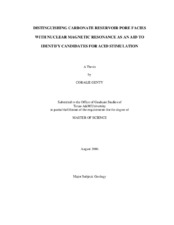| dc.description.abstract | The determination of reservoir quality and its spatial distribution is a key objective in
reservoir characterization. This is especially challenging for carbonates because, due to
the effects of diagenesis, quality rarely follows depositional patterns. This study
integrates data from thin sections and core analyses with measurements of Nuclear
Magnetic Resonance (NMR) T2 relaxation times. It exposes a novel approach to the use
of NMR by applying geological and statistical analysis to define relationships between
pore characteristics and the T2 data, from which a method to identify pore origin from
NMR only is developed.
One hundred and three samples taken from eleven wells located in fields of the
Middle East, Alabama and Texas were used in the study. Modeling of the T2 spectra, as
the sum of three normal components, resulted in the definition of 9 parameters
representing the average, the variability and the percentage of total porosity of the
specific pore sizes present in the sample. Each specific pore size corresponds to one of
the following genetic pore types: intergranular, matrix, dissolution-enhanced,
intercrystalline, vuggy and cement-reduced. Among the 9 parameters, two variables were
identified as having the highest degree of geological significance that could be used to
discriminate between pore categories: µmax which represents the largest average pore size
of all pore types identified in the sample, and Ãmain which represents the size variability
of the most abundant pore type. Based on the joint distribution of µmax and Ãmain
computed for each pore category, the probability that an unclassified sample belongs to
each of the pore categories, is calculated and the sample is assigned to the category with
the highest probability. The accuracy of the method was investigated by comparing NMR predicted pore
origin and genetic pore type described from thin section. A result of 89 successful
predictions out of 103 samples was obtained. These promising results indicate that T2
time can be a useful identifier of carbonate pore types. Success in this work takes us
closer to identifying genetic pore types from NMR logs with minimal calibration against
borehole cores and will help predict the spatial distribution of poroperm facies in
complex carbonate reservoirs with much improved accuracy. | en |


